机械工程专业英语 第三课文及阅读材料-推荐下载
- 格式:pdf
- 大小:141.96 KB
- 文档页数:7
![机械专业英语3-4[59P][2.47MB]](https://uimg.taocdn.com/8055c055312b3169a451a48b.webp)
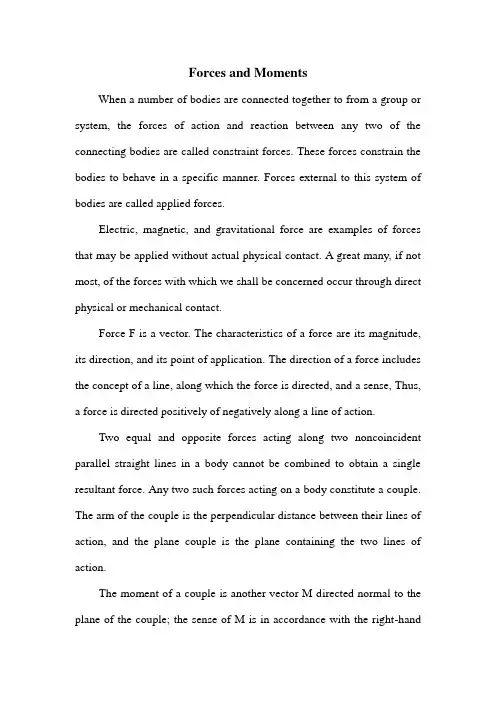
Forces and MomentsWhen a number of bodies are connected together to from a group or system, the forces of action and reaction between any two of the connecting bodies are called constraint forces. These forces constrain the bodies to behave in a specific manner. Forces external to this system of bodies are called applied forces.Electric, magnetic, and gravitational force are examples of forces that may be applied without actual physical contact. A great many, if not most, of the forces with which we shall be concerned occur through direct physical or mechanical contact.Force F is a vector. The characteristics of a force are its magnitude, its direction, and its point of application. The direction of a force includes the concept of a line, along which the force is directed, and a sense, Thus, a force is directed positively of negatively along a line of action.Two equal and opposite forces acting along two noncoincident parallel straight lines in a body cannot be combined to obtain a single resultant force. Any two such forces acting on a body constitute a couple. The arm of the couple is the perpendicular distance between their lines of action, and the plane couple is the plane containing the two lines of action.The moment of a couple is another vector M directed normal to the plane of the couple; the sense of M is in accordance with the right-handrule for rotation. The magnitude of the moment is the product of the arm of the couple and the magnitude of one of the forces.A rigid body is in static equilibrium if:(1) The vector sum of all forces acting upon it is zero.(2) The sum of the moments of all the forces acting about any single axis is zero.Mathematically these two statements are expressed asThe term “rigid body”as used here may be an entire machine, several connected parts of a machine, a single part, or a portion of a part.A free-body diagram is a sketch of drawing of the body, isolated form the machine, on which the forces and moments are shown in action. It is usually desirable to include on the diagram the known magnitudes and directions as well as other pertinent information.The diagram so obtained is called “free” because the part or portion of the body has been freed from the remaining machine elements and their effects have been replaced by forces shown on is are the external forces(applied forces) and moments exerted by adjoining or connected parts. If the diagram is a portion of a part, the forces and moments acting on the cut portion are the internal forces and moments exerted by the part that has been cut away.The construction and presentation of clear and neatly drawnfree-body diagrams represent the heart of engineering communication. This is true because they represent the heart of engineering communication. This is true because they represent a part of the thinking process, whether they are actually placed on paper or not, and because the construction of these diagrams is the only way the results of thinking can be communicated to others. You should acquire the habit of drawing free-body diagrams no matter how simple the problem may appear to be. Construction of the diagrams speeds up the problem-solving process and greatly decreases the chances of making mistakes.The advantages of using free-body diagrams can be summarized as follows:(1)They make it easy for one to translate words and thoughtsand ideas into physical models.(2)They assist in seeing and understanding all facets of aproblem.(3)They help in planning the attack on the problem.(4)They make mathematical relations easier to see or find.(5)Their use makes it easy to keep track of one’s progress andhelps in making simplifying assumptions.(6)The methods used in the solution may be stored for futurereference.(7)They assist your memory and make it easier to explain andpresent your work to others.In analyzing the forces in machines we shall almost always need to separate the machine into its individual components and construct free-body diagrams showing the forces that act upon each component. Many of these part will be connected to each other by kinematic pairs.。
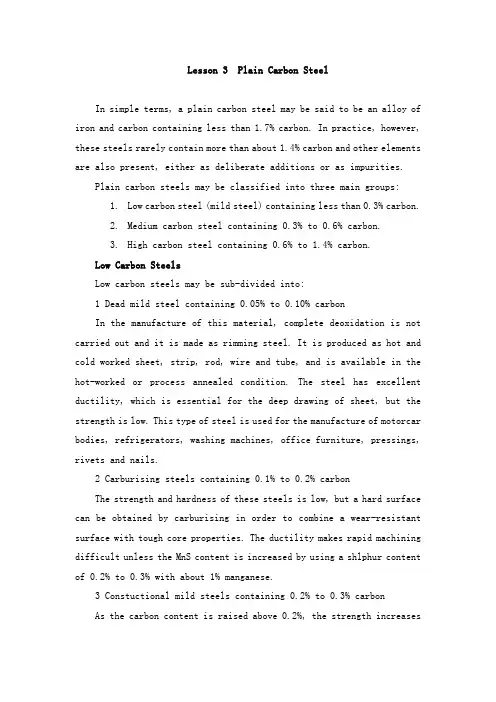
Lesson 3 Plain Carbon SteelIn simple terms, a plain carbon steel may be said to be an alloy of iron and carbon containing less than 1.7% carbon. In practice, however, these steels rarely contain more than about 1.4% carbon and other elements are also present, either as deliberate additions or as impurities.Plain carbon steels may be classified into three main groups:1.Low carbon steel (mild steel) containing less than 0.3% carbon.2.Medium carbon steel containing 0.3% to 0.6% carbon.3.High carbon steel containing 0.6% to 1.4% carbon.Low Carbon SteelsLow carbon steels may be sub-divided into:1 Dead mild steel containing 0.05% to 0.10% carbonIn the manufacture of this material, complete deoxidation is not carried out and it is made as rimming steel. It is produced as hot and cold worked sheet, strip, rod, wire and tube, and is available in the hot-worked or process annealed condition. The steel has excellent ductility, which is essential for the deep drawing of sheet, but the strength is low. This type of steel is used for the manufacture of motorcar bodies, refrigerators, washing machines, office furniture, pressings, rivets and nails.2 Carburising steels containing 0.1% to 0.2% carbonThe strength and hardness of these steels is low, but a hard surface can be obtained by carburising in order to combine a wear-resistant surface with tough core properties. The ductility makes rapid machining difficult unless the MnS content is increased by using a shlphur content of 0.2% to 0.3% with about 1% manganese.3 Constuctional mild steels containing 0.2% to 0.3% carbonAs the carbon content is raised above 0.2%, the strength increasesinto the range required for constructional purposes, but the ductility decreases. The fabrication qualities of this material are very good. The steel is hot-rolled into plate for making boilers, ships and vehicles, and also into sections for use in bridges and buildings. The steel is often used in the hot-rolled condition, but the smaller sized material may be normalized.It has been estimated that about 90% (by weight) of all steel used is of this low carbon classification.Medium Carbon SteelsMedium carbon steels are often quenched-hardened and fully tempered to give good strength with maximum toughness, which are the properties required of components such as shafts, gears and connecting rods. Steels containing 0.4% to 0.5% carbon may also be surface hardened by localized heating and quenching.High Carbon SteelsHigh carbon steels are quench hardened and lightly tempered to give high hardness with only limited toughness. Material in this classification is mainly used for making fairly small, relatively inexpensive cutting tools so that the group as a whole is known as carbon tool steel. Steels containing 0.6% to 0.8% carbon are used for making dies, springs, wire ropes and railway tyres. Many different kind of tools are made from higher carbon steels as indicated below.Limitations of Plain Carbon SteelsPlain carbon steels have many limitations including the following:a)If reasonable toughness and ductility are required, themaximum tensile strengthobtainable is about 700 N/mm2.b)Large sections cannot be effectively hardened, thusrestricting their use to relatively thin sections.c)Water quenching is necessary for full hardening withconsequent risk of distortion and cracking.d)Rapid softening above about 300 o C limits their use forhigh-speed metal cutting.e)Poor resistance to corrosion and to oxidation at elevatedtemperatures.To overcome these limitations, additional elements are added to the steel to give alloy steels with specific properties. The main alloying elements include manganese, nickel, chromium, molybdenum, tungsten, vanadium, cobalt and silicon.New words学习1.deliberate 故意的2.managanese 锰3.impurity 杂质,夹杂物4.sulphur 硫……Notes1.Ii is produced as hot and cold worked sheet, strip, rod, wireand tube, and is available in the hot-worked or process annealed condition.这种钢被制造成冷轧或热轧的钢板、棒材、带材、线材和管材,适宜在热加工状态或退火状态下使用。
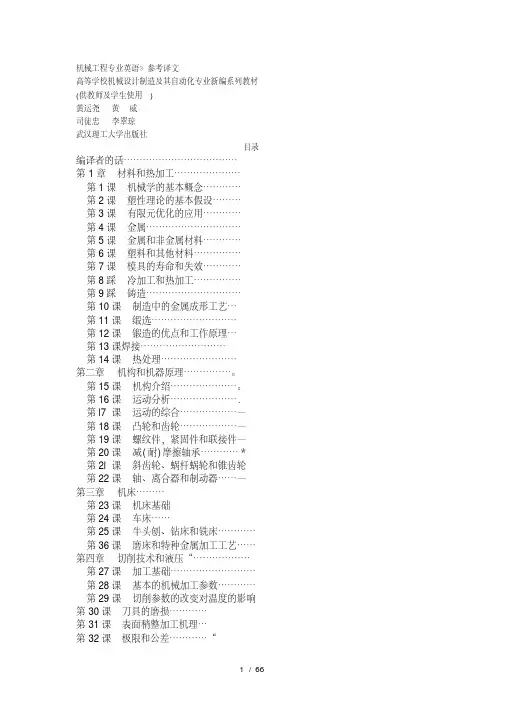
机械工程专业英语》参考译文高等学校机械设计制造及其自动化专业新编系列教材(供教师及学生使用)黄运尧黄威司徒忠李翠琼武汉理工大学出版社目录编译者的话………………………………第1章材料和热加工…………………第1课机械学的基本概念…………第2课塑性理论的基本假设………第3课有限元优化的应用…………第4课金属…………………………第5课金属和非金属材料…………第6课塑料和其他材料……………第7课模具的寿命和失效…………第8踩冷加工和热加工……………第9踩铸造…………………………第10课制造中的金属成形工艺…第11课缎选………………………第12课锻造的优点和工作原理…第13课焊接………………………第14课热处理……………………第二章机构和机器原理……………。
第15课机构介绍…………………。
第16课运动分析………………….第l7课运动的综合………………—第18课凸轮和齿轮………………—第19课螺纹件,紧固件和联接件—第20课减(耐)摩擦轴承…………*第2l课斜齿轮、蜗杆蜗轮和锥齿轮第22课轴、离合器和制动器……—第三章机床………第23课机床基础第24课车床……第25课牛头刨、钻床和铣床…………第36课磨床和特种金属加工工艺……第四章切削技术和液压“………………第27课加工基础………………………第28课基本的机械加工参数…………第29课切削参数的改变对温度的影响第30课刀具的磨损…………第31课表面稍整加工机理…第32课极限和公差…………“第33课尺寸控制和表面桔整”第34课自动央具设计………“第36课变速液压装置……………—…………—策37课电液伺服系统…………。
……………。
第五章机械电子技术………………………………第38课专家系统……。
…………………………第3D课建筑机器人………………………………第40课微机为基础的机器人模拟………………第41课机器人学的定义和机器入系统…………第42课微型计算机基础(1)……………………第43课微型计算机基础(x)……………………第44课可编程控制器……………………………第45课CAD/CAM计算机辅助设计与制造…第46课计算机数控和直接数控,CNC和DNC第47课加工过程的数控—………………………第48课柔性制造系统……………—……………第仍课交互式编程系统…………………………第50课在振动分析方面的计算机技术…………策51课压力传感器………………………………第52课反馈元件…………………—……………第53课现代按制理论概述………………………第54课管理上采取了新的措施—来自福持汽第六章英文科技文献和专利文献的查阅…………6.1 常见科技文献及其查阅………………………6.2 专利文献概述…………………………………第七章英文科拉论文写作…………………………7.1 标题与摘要写法………………………………7.2 正文(body)的组织与写法…………………7.3 致谢、附录及参考文献………………—……参考文献………………………………………………第1章材料和热加工机械学的基本概念功是力乘以该力作用在物体上佼物体移动的距离。
![机械专业职场英语[杨成]第三章](https://uimg.taocdn.com/ae590b4f561252d380eb6ed0.webp)
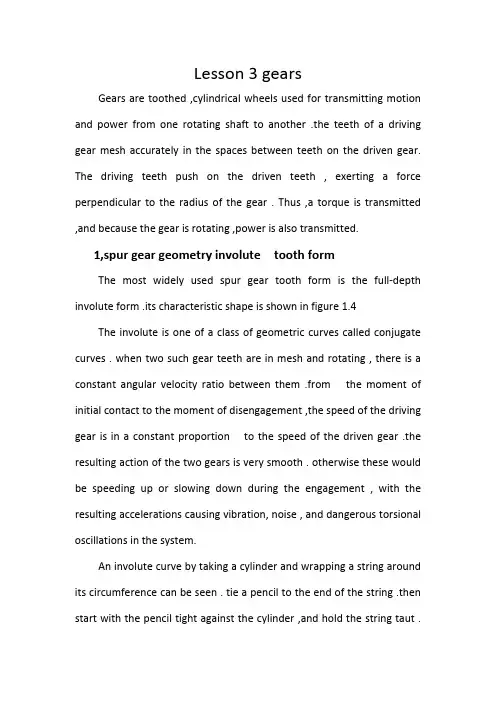
Lesson 3 gearsGears are toothed ,cylindrical wheels used for transmitting motion and power from one rotating shaft to another .the teeth of a driving gear mesh accurately in the spaces between teeth on the driven gear. The driving teeth push on the driven teeth , exerting a force perpendicular to the radius of the gear . Thus ,a torque is transmitted ,and because the gear is rotating ,power is also transmitted.1,spur gear geometry involute tooth formThe most widely used spur gear tooth form is the full-depth involute form .its characteristic shape is shown in figure 1.4The involute is one of a class of geometric curves called conjugate curves . when two such gear teeth are in mesh and rotating , there is a constant angular velocity ratio between them .from the moment of initial contact to the moment of disengagement ,the speed of the driving gear is in a constant proportion to the speed of the driven gear .the resulting action of the two gears is very smooth . otherwise these would be speeding up or slowing down during the engagement , with the resulting accelerations causing vibration, noise , and dangerous torsional oscillations in the system.An involute curve by taking a cylinder and wrapping a string around its circumference can be seen . tie a pencil to the end of the string .then start with the pencil tight against the cylinder ,and hold the string taut .move the pencil away from the cylinder while keeping the string taut . the curve drawed is an involuteThe circle represented by the cylinder is called the base circle . notice that at any position on the curve , the string represents a line tangent to the base circle and ,at the same time , perpendicular to the involute . drawing another base circle along the same centerline in such a position that the resulting involute is tangent to the first one ,it demonstrates that at the point of contact, the two lines tangent to the base circles are coincident and will stay in the same position as the base circles rotate . this is what happens when two gear teeth are in mesh .It is a fundamental principle of kinematics, the study of motion, that if the line drawn perpendicular to the surfaces of two rotating bodies at the point of contact always crosses the centerline between the two bodies at the same place , the angular velocity ratio of the two bodies will be constant . this is a statement of gearing .as demonstrated here ,the gear teeth made in the involute-tooth form obey the law.2,helical gear geometryHelical and spur gears are distinguished by the orientation of their teeth .on spur gears ,the teeth are straight and are aligned with the axis of the gear .on helical gears , the teeth are inclined at an angle with the axis, that angle being called the helix angle. If the gear was very wide ,it would appear that the teeth wind around the gear blank in acontinuous , helical path . however , practical considerations limit the width of the gears so that the teeth normally appear to be merely inclined with respect to the axis .figure 1.5 shows two examples of commercially available helical gears.The form of helical gear teeth are very similar to those discussed for spur gears . the basic task is to account for the effect of the helix angle .3,helix angleThe helix for a given gear can be either left-hand or right-hand . the teeth of a right-hand helical gear would appear to lean to the right when the gear is lying on a flat surface . conversely , the teeth of a left-hand helical gear would lean to the left . in normal installation , helical gears would be mounted on parallel shafts . to achieve this arrangement ,it is required that one gear should be of the right-hand design and that the other be left-hand with an equal helix angle .if both gears in mesh are of the same hand ,the shafts will be at 90 degrees to each other . such gears are called crossed helical gears.The parallel shaft arrangement for helical gears is preferred because it results in a much higher power-transmitting capacity for a given size of gear than the crossed helical arrangement .The main advantage of helical gears over spur gears is smoother engagement because a given tooth assumes its load gradually instead of suddenly .contact starts at one end of a tooth near the tip andprogresses across the face in a path downward across the pitch line to the lower flank of the tooth , where it leaves engagement .simultaneously , other teeth are coming into engagement before a given tooth leaves engagement , with the result that a larger average number of teeth are engaged and are sharing the applied loads compared with a spur gear . the lower average load per tooth allows a greater power transmission capacity for a given size of gear , or a smaller gear can be designed to carry the same power .The main disadvantage of helical gears is that an axial thrust load is produced as a natural result of the inclined arrangement of the teeth. The bearings that hold the shaft carrying the helical gear must be capable of reacting against the thrust load.Reading materialTypes of gearsSeveral kinds of gears having different tooth geometries are in common use . the acquaint you with the general appearance of some , their basic descriptions are given here .Spur gears have teeth that are straight and arranged parallel to the axis of the shaft that carries the gear . the curved shape of the faces of the spur gear teeth has a special geometry called an involute curve . this shape makes it possible for two gears to operate together withsmooth, positive transmission of power .The teeth of helical gears are arranged so that they lie at an angle with respect to the axis of the shaft . the angle ,called the helix angle ,can be virtually any angle . typical helix angle range from approximately 10 to 30 ,but angles up to 45 are practical .the helical teeth operate more smoothly than equivalent spur gear teeth ,and stresses are lower. Therefore ,a smaller helical gear can be designed for a given power-transmitting capacity than a spur gear. One of the disadvantages of helical gears is that an axial force , called a thrust force ,is generated in addition to the driving force that acts tangent to the basic cylinder on which the teeth are arranged . the designer must consider the thrust force when selecting bearing that will hold the shaft during operation . shafts carrying helical gears are typically arranged parallel to each other .however ,a special design ,called crossed helical gears ,has 45 helix angles, and the shafts operate 90 to each other .Bevel gears have teeth that are arranged as elements on the surface of cone . the teeth of straight bevel gears appear to be similar to spur gear teeth ,but they are tapered , being wider at the outside and narrower at the top of the cone ,bevel gears typically operate on shafts that are 90 to each other .indeed ,this is often the reason for specifying bevel gears in a drive system ,specially designed bevel gears can operate on shafts that are at some angel other than 90. Whenbevel gears are made with teeth that form a helix angle similar to that in helical gears , they are called spiral bevel gears. They operate more smoothly than straight bevel gears and can be made smaller for a given power transmission capacity . when both bevel gears in a pair have the same number of teeth ,they are called miter gears and are used only to change the axes of the shaft to 90 degrees . no speed change occurs .A rack is a straight gear that moves linearly instead of rotating . when a circular gear is mated with a rack , the combination is called a rack and pinion drive . you may have heart that term applied to the steering mechanism of a car or to a part of other machinery .A worm and its mating worm gear operate on shafts that are at90 degrees to each other . they typically accomplish a rather large speed reduction ratio compared with other types of gears . the worm is the driver ,and the worm gear is the driven gear. The teeth on the worm appear similar to screw threads, and , indeed , they are often called threads rather than teeth . the teeth of the worm gear can be straight like spur gear teeth ,or they can be helical. Often the shape of the tip of the worm gear teeth is enlarged to partially wrap around the threads of the worm to improve the power transmission capacity of the set . one disadvantage of the worm / worm gear drive is that it has a somewhat lower mechanical efficiency than most other kinds of gears because there is extension rubbing contact between the surfaces of the wormthreads and the sides of the worm gear teeth.Think of examples of gears in actual equipment . describe the operation of the equipment , particularly the power transmission system . sometimes ,of course ,the gears and the shafts are enclosed in housing , making it difficult for you to observe the actual gears. Perhaps you can find a manual for the equipment that shows the drive system. Try to answer the following questions:(1)What was the source of the power ,an electric motor, a gasolineengine , a steam turbine , or a hydraulic motor ?were the gears operated by hand?(2) How were the gears arranged together, and how were they attachedto the driving source and the driven machine?(3)Was there a speed change ? can you determine how much of achange ?(4)Were there more than two gears operated by hand ?(5)What types of gears were used?(6)What materials were gears made from ?(7)How were the gears attached to the shafts that supported them ?(8)Were the shafts for mating gears aligned parallel to each other ,orwere they perpendicular to one another ?(9)How were the shafts themselves supported ?(10)Was the gear transmission system enclosed in housing?。
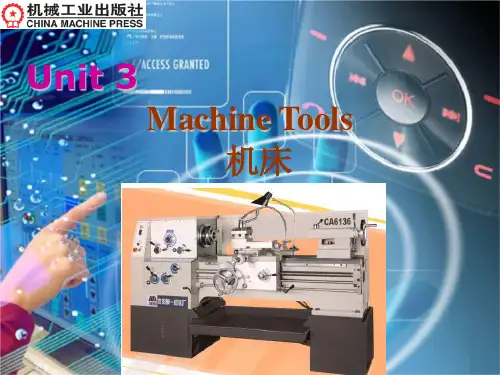
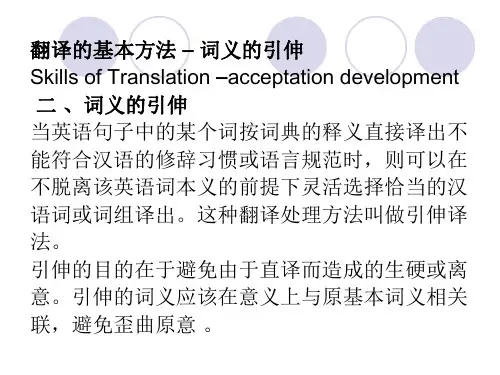
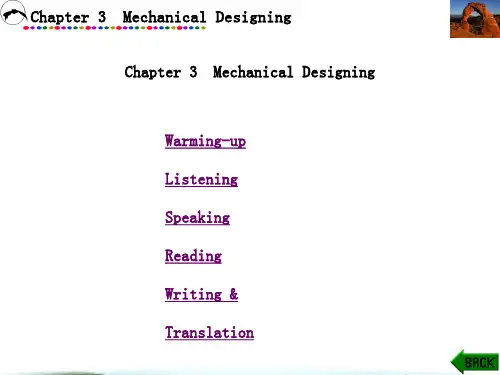

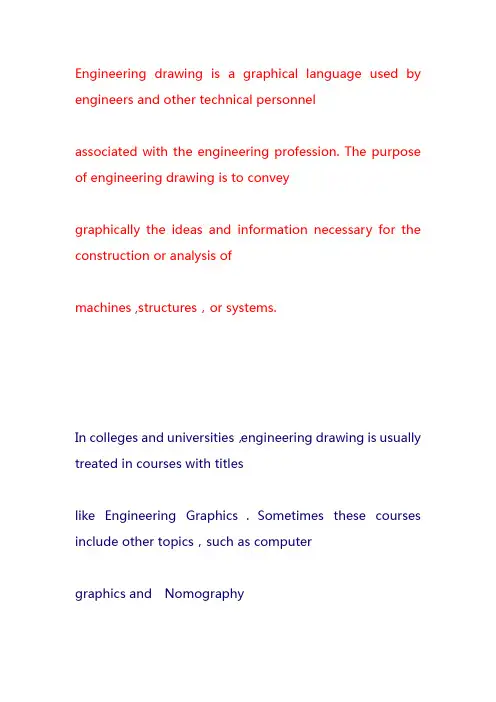
Engineering drawing is a graphical language used by engineers and other technical personnelassociated with the engineering profession. The purpose of engineering drawing is to conveygraphically the ideas and information necessary for the construction or analysis ofmachines ,structures,or systems.In colleges and universities,engineering drawing is usually treated in courses with titleslike Engineering Graphics.Sometimes these courses include other topics,such as computergraphics and NomographyThe basis for much engineering drawing is orthographic representation (projection). Objectsare depicted by front, top, side, auxiliary, or oblique views, or combinations of these.The complexity of an object determines the number of views shown. At times, pictorial viewsare shown.Engineering drawings often include such features as various types of lines, dimensions,lettered notes, sectional views, and symbols. They may bein the form of carefully plannedand checked mechanical drawings, or they may be freehand sketches. Usually a sketchprecedes the mechanical drawing. Final drawings are usually made on tracing paper, cloth orMylar film, so that many copies can be made quickly and cheaply by such processes as,blueprinting, ammonia-developed printing, or lithography.Many objects have complicated interior details which cannot be clearly shown by means offront, top, side, or pictorial views. Section views enable the engineer or detailer to showthe interior detail in such cases. Features of sectiondrawings are cutting-plane symbols,which show where imaginary cutting planes are passed to produce the sections, and section-lining (sometimes called cross-hatching), which appears in the section view on all portionsthat have been in contact with the cutting plane. When only a part of the object is to beshown in section, conventional representation such as a revolved, rotated, or broken-outsection is used. Details such as flat surface, knurls, and threads are treatedconventionally, which facilities the making and reading of engineering drawings byexperienced personnel. Thus, certain engineering drawings will be combinations of top andfront views, section and rotated view, and partial or pictorial views.In addition to describing the shape of objects, many drawings must show dimensions, so thatworkers can build the structure or fabricate parts that will fit together. This isaccomplished by placing the required values (measurements) along dimension lines (usuallyoutside the outlines of the object) and by giving additional information in the form ofnotes which are referenced to the parts in question byangled lines called leaders. Indrawings of large structures the major unit is the foot, and in drawings of small objectsthe unit is the inch. In metric dimensioning, the basic unit may be the meter, or themillimeter, depending upon the size of the object or structure.Working types of drawings may differ in styles of dimensioning, lettering (inclinedlowercase, vertical uppercase, and so on), positioning of the numbers (aligned, orunidirectional –a style in which all numbers are lettered horizontally), and in the typeof fraction used (common fractions or decimal fractions).If special precision is required,and upper and lower allowable limit are shown. Such tolerance, or limit, dimensioning isnecessary for the manufacture of interchangeable mating parts, but unnecessarily closetolerances are very expensive.Layout Drawings Layout drawings of different types are used in different manufacturingfields for various purposes.One is the plant layout drawing,in which the outline of the building,work areas, aisles, and individual items of equipment areall drawn to scale. Another typeis the aircraft, or master,layout, which is drawn on glass cloth or on steel or aluminum sheets.The object is drawn to full size with extreme accuracy. The completed drawing is photographed with great precision, and a glass negative made. Fromthis negative,photo templates are made on photosensitized metal in various sizes and for differentpurposes,thereby eliminating the need for many conventional detail drawings.Another type of layout, or preliminary assembly, drawing is the design layout, which establishes the position and clearance of parts of anassembly.A set of working drawings usually includes detail drawings of all parts and an assemblydrawing of the complete unit. Assembly drawings vary somewhat in character according totheir use, as design assemblies or layouts; working drawing assemblies; general assemblies;installation assemblies; and check assemblies. A typical general assembly may includejudicious use of sectioning and identification of each part with a numberedballoon. Accompanying such a drawing is parts list, in which each part is listed by numberand briefly described; the number of pieces required isstated and other pertinentinformation given. Parts lists are best placed on separate sheets and typewritten to avoidtime-consuming and costly hand lettering.Schematic or diagrammatic drawings make use of standard symbols and single lines betweensymbols which indicate the direction of flow. In piping and electrical schematic diagrams,symbols recommended by the American National Standards Institute (ANS I), other agencies,or the Department of the Defense (DOD) are used. The fixtures or components are not labeledin most schematics because readers usually know what the symbols represent.Additional information is often lettered on schematic drawing, for example, theidentification of each replaceable electrical component. Etched-circuit drawing hasrevolutionized the wiring of electronic components. By means of such drawing, the wiring ofan electronic circuit is photographed on a copper-clad board, and unwanted areas are etchedaway. On electrical and other types of flow diagrams, all single lines (often with arrowsshowing direction of flow) are drawn horizontally or vertically; there are few exceptions.In some flow diagrams, rectangular enclosures are used for all items. Lettering is usuallyplaced within the enclosuresStructural Drawings Structural drawings include design and working drawings for structuressuch as buildings, bridges, dams, tanks, and highways. Such drawings form the basis oflegal contracts. Structural drawings embody the same principles as do other engineeringdrawings, but use terminology and dimensioning techniques different from those shown inprevious illustrations.1工程图是一种图形语言使用的工程师和其他技术人员与工程相关的职业。
第三课Overview of Engineering Mechanics工程力学概述当我们观察我们周围就会发现世界充满“物品”:机器,设备,工具;我们已经设计,建造,并使用的物品;木头,金属,陶瓷和塑料制品。
根据我们使用的经验知道,有些物品比其它物品更好;他们使用寿命较长,费用较低,噪音更低,更好看,或者更方便我们使用。
然而,在理想的情况下,每一件产品都是设计人员工具其对某些“功能要求”的理解而设计出来的,也就是说,在设计过程中,应该回答这样的问题,即“它应该具有哪种确切的功能?”在工程领域,主要功能通常是承受由于重力,惯性力,压力等作用的一些类型的载荷。
从我们居住房屋的梁到飞机机翼,都必须有一个适当的材料,尺寸,在较合理的寿命基础上具有较合理的成本并能可靠地完成其功能的产品结构连接的组合。
在实践中,工程力学方法常被应用在两个完全不同领域:(1) 任何新装置的研发都需要对其结构,尺寸,材料,载荷,耐久性,安全和成本的反复考虑。
(2) 当一个装置(意外地)发生失效后,通常需要进行研究,找出失效的原因,并找出潜在的纠正措施。
最好的设计往往都是不断排除薄弱环节的演变过程。
对许多工程师来说,上述过程既可以令人非常的陶醉又可以使人非常的愉快,更何况(有时)对我们是有利的。
对于任何实际的问题,总是缺乏足够完整和有用的信息。
我们很少准确地知道实际荷载和工作状态,因此,所做的分析工作也很少是精确的。
虽然我们的数学可以准确,全面的分析一般只能近似,而且不同技术水平的人能得到不同的解。
在工程力学研究领域,大多数问题要想得到唯一解就要充分的理想化,但应该清楚,“现实世界”远不非理想化程度,因此为了得到问题的解决方案不得不进行一些理想化假设。
我们要考虑的技术领域通常被称为“静力学”和“材料力学”,“静力学”,指的是研究作用在固定装置上的作用力,“材料力学”指的是施加到结构的力(变形,载荷限制等)的影响。
但是,事实上很多设备都不是静态的,如果与动力学有关的额外负荷被考虑了的话,那么静力学的研究方法完全适用于动态的情况,只要动态力相对静态载荷较小,系统通常被认为是静态的。
机械工程专业英语教程第一课:机械工程简介Introduction to Mechanical EngineeringSection 1: OverviewMechanical engineering is a diverse and dynamic field that encompasses the design, development, and operation of machinery, structures, and systems. This branch of engineering plays a crucial role in various industries, including automotive, aerospace, manufacturing, and energy.Section 2: Responsibilities and SkillsAs a mechanical engineer, your responsibilities will include designing and analyzing mechanical systems, conducting tests and experiments, and supervising the manufacturing process. You will also need to have a strong understanding of physics, mathematics, and computer-aided design (CAD). Additionally, problem-solving skills, attention to detail, and the ability to work well in teams are essential.Section 3: Career OpportunitiesA degree in mechanical engineering can open up a wide range of career opportunities. You could work in research and development, product design, manufacturing, or projectmanagement. Mechanical engineers are in demand in almost every industry, ensuring a stable and rewarding career path.Section 4: University CoursesTo become a mechanical engineer, it is essential to pursue a degree in mechanical engineering from a reputable university. The curriculum typically includes courses in engineering principles, materials science, thermodynamics, fluid mechanics, and mechanical design. Additionally, practical training through internships or cooperative education programs is crucial for gaining hands-on experience.Section 5: ConclusionMechanical engineering offers a challenging and rewarding career for those with a passion for solving problems and a desire to create innovative solutions. With the right education and skills, you can embark on a successful journey in the field of mechanical engineering. Remember, the possibilities are endless in this ever-evolving discipline.第二课:机械设计基础Fundamentals of Mechanical DesignSection 1: IntroductionIn this lesson, we will explore the fundamentals of mechanical design. Mechanical design involves the creation and development of physical systems and components that meet specific requirements and specifications. This processrequires a deep understanding of materials, mechanics, and engineering principles.Section 2: Design ProcessThe design process typically follows a systematic approach that includes several stages. These stages include problem identification, conceptual design, detailed design, manufacturing, and testing. Each stage involves various activities such as brainstorming, prototyping, and evaluation.Section 3: Design ConsiderationsDuring the design process, there are several important considerations to keep in mind. These include functionality, efficiency, reliability, safety, and cost-effectiveness. It is also crucial to consider the environmental impact and sustainability of the design.Section 4: Tools and SoftwareTo aid in the design process, engineers use various tools and software. Computer-aided design (CAD) software allows for precise modeling and simulation of mechanical systems. Finite element analysis (FEA) software helps in analyzing the structural integrity and performance of designs.Section 5: Case StudyTo further understand the application of mechanical design principles, we will examine a case study. This real-world example will demonstrate how the design process isimplemented to solve a specific problem and achieve desired outcomes.Section 6: ConclusionMechanical design is a critical aspect of mechanical engineering. It requires a combination of creativity, technical knowledge, and attention to detail. By mastering the fundamentals of mechanical design, you will be well-equippedto tackle complex challenges and contribute to the development of innovative solutions.以上是《机械工程专业英语教程》的课文翻译。
Lesson 3 gearsGears are toothed ,cylindrical wheels used for transmitting motion and power from one rotating shaft to another .the teeth of a driving gear mesh accurately in the spaces between teeth on the driven gear. The driving teeth push on the driven teeth , exerting a force perpendicular to the radius of the gear . Thus ,a torque is transmitted ,and because the gear is rotating ,power is also transmitted.1,spur gear geometry involute tooth formThe most widely used spur gear tooth form is the full-depth involute form .its characteristic shape is shown in figure 1.4The involute is one of a class of geometric curves called conjugate curves . when two such gear teeth are in mesh and rotating , there is a constant angular velocity ratio between them .from the moment of initial contact to the moment of disengagement ,the speed of the driving gear is in a constant proportion to the speed of the driven gear .the resulting action of the two gears is very smooth . otherwise these would be speeding up or slowing down during the engagement , with the resulting accelerations causing vibration, noise , and dangerous torsional oscillations in the system.An involute curve by taking a cylinder and wrapping a string around its circumference can be seen . tie a pencil to the end of the string .then start with the pencil tight against the cylinder ,and hold the string taut .move the pencil away from the cylinder while keeping the string taut . the curve drawed is an involuteThe circle represented by the cylinder is called the base circle . notice that at any position on the curve , the string represents a line tangent to the base circle and ,at the same time , perpendicular to the involute . drawing another base circle along the same centerline in such a position that the resulting involute is tangent to the first one ,it demonstrates that at the point of contact, the two lines tangent to the base circles are coincident and will stay in the same position as the base circles rotate . this is what happens when two gear teeth are in mesh .It is a fundamental principle of kinematics, the study of motion, that if the line drawn perpendicular to the surfaces of two rotating bodies at the point of contact always crosses the centerline between the two bodies at the same place , the angular velocity ratio of the two bodies will be constant . this is a statement of gearing .as demonstrated here ,the gear teeth made in the involute-tooth form obey the law.2,helical gear geometryHelical and spur gears are distinguished by the orientation of their teeth .on spur gears ,the teeth are straight and are aligned with the axis of the gear .on helical gears , the teeth are inclined at an angle with the axis, that angle being called the helix angle. If the gear was very wide ,it would appear that the teeth wind around the gear blank in acontinuous , helical path . however , practical considerations limit the width of the gears so that the teeth normally appear to be merely inclined with respect to the axis .figure 1.5 shows two examples of commercially available helical gears.The form of helical gear teeth are very similar to those discussed for spur gears . the basic task is to account for the effect of the helix angle .3,helix angleThe helix for a given gear can be either left-hand or right-hand . the teeth of a right-hand helical gear would appear to lean to the right when the gear is lying on a flat surface . conversely , the teeth of a left-hand helical gear would lean to the left . in normal installation , helical gears would be mounted on parallel shafts . to achieve this arrangement ,it is required that one gear should be of the right-hand design and that the other be left-hand with an equal helix angle .if both gears in mesh are of the same hand ,the shafts will be at 90 degrees to each other . such gears are called crossed helical gears.The parallel shaft arrangement for helical gears is preferred because it results in a much higher power-transmitting capacity for a given size of gear than the crossed helical arrangement .The main advantage of helical gears over spur gears is smoother engagement because a given tooth assumes its load gradually instead of suddenly .contact starts at one end of a tooth near the tip andprogresses across the face in a path downward across the pitch line to the lower flank of the tooth , where it leaves engagement .simultaneously , other teeth are coming into engagement before a given tooth leaves engagement , with the result that a larger average number of teeth are engaged and are sharing the applied loads compared with a spur gear . the lower average load per tooth allows a greater power transmission capacity for a given size of gear , or a smaller gear can be designed to carry the same power .The main disadvantage of helical gears is that an axial thrust load is produced as a natural result of the inclined arrangement of the teeth. The bearings that hold the shaft carrying the helical gear must be capable of reacting against the thrust load.Reading materialTypes of gearsSeveral kinds of gears having different tooth geometries are in common use . the acquaint you with the general appearance of some , their basic descriptions are given here .Spur gears have teeth that are straight and arranged parallel to the axis of the shaft that carries the gear . the curved shape of the faces of the spur gear teeth has a special geometry called an involute curve . this shape makes it possible for two gears to operate together withsmooth, positive transmission of power .The teeth of helical gears are arranged so that they lie at an angle with respect to the axis of the shaft . the angle ,called the helix angle ,can be virtually any angle . typical helix angle range from approximately 10 to 30 ,but angles up to 45 are practical .the helical teeth operate more smoothly than equivalent spur gear teeth ,and stresses are lower. Therefore ,a smaller helical gear can be designed for a given power-transmitting capacity than a spur gear. One of the disadvantages of helical gears is that an axial force , called a thrust force ,is generated in addition to the driving force that acts tangent to the basic cylinder on which the teeth are arranged . the designer must consider the thrust force when selecting bearing that will hold the shaft during operation . shafts carrying helical gears are typically arranged parallel to each other .however ,a special design ,called crossed helical gears ,has 45 helix angles, and the shafts operate 90 to each other .Bevel gears have teeth that are arranged as elements on the surface of cone . the teeth of straight bevel gears appear to be similar to spur gear teeth ,but they are tapered , being wider at the outside and narrower at the top of the cone ,bevel gears typically operate on shafts that are 90 to each other .indeed ,this is often the reason for specifying bevel gears in a drive system ,specially designed bevel gears can operate on shafts that are at some angel other than 90. Whenbevel gears are made with teeth that form a helix angle similar to that in helical gears , they are called spiral bevel gears. They operate more smoothly than straight bevel gears and can be made smaller for a given power transmission capacity . when both bevel gears in a pair have the same number of teeth ,they are called miter gears and are used only to change the axes of the shaft to 90 degrees . no speed change occurs .A rack is a straight gear that moves linearly instead of rotating . when a circular gear is mated with a rack , the combination is called a rack and pinion drive . you may have heart that term applied to the steering mechanism of a car or to a part of other machinery .A worm and its mating worm gear operate on shafts that are at90 degrees to each other . they typically accomplish a rather large speed reduction ratio compared with other types of gears . the worm is the driver ,and the worm gear is the driven gear. The teeth on the worm appear similar to screw threads, and , indeed , they are often called threads rather than teeth . the teeth of the worm gear can be straight like spur gear teeth ,or they can be helical. Often the shape of the tip of the worm gear teeth is enlarged to partially wrap around the threads of the worm to improve the power transmission capacity of the set . one disadvantage of the worm / worm gear drive is that it has a somewhat lower mechanical efficiency than most other kinds of gears because there is extension rubbing contact between the surfaces of the wormthreads and the sides of the worm gear teeth.Think of examples of gears in actual equipment . describe the operation of the equipment , particularly the power transmission system . sometimes ,of course ,the gears and the shafts are enclosed in housing , making it difficult for you to observe the actual gears. Perhaps you can find a manual for the equipment that shows the drive system. Try to answer the following questions:(1)What was the source of the power ,an electric motor, a gasolineengine , a steam turbine , or a hydraulic motor ?were the gears operated by hand?(2) How were the gears arranged together, and how were they attachedto the driving source and the driven machine?(3)Was there a speed change ? can you determine how much of achange ?(4)Were there more than two gears operated by hand ?(5)What types of gears were used?(6)What materials were gears made from ?(7)How were the gears attached to the shafts that supported them ?(8)Were the shafts for mating gears aligned parallel to each other ,orwere they perpendicular to one another ?(9)How were the shafts themselves supported ?(10)Was the gear transmission system enclosed in housing?。